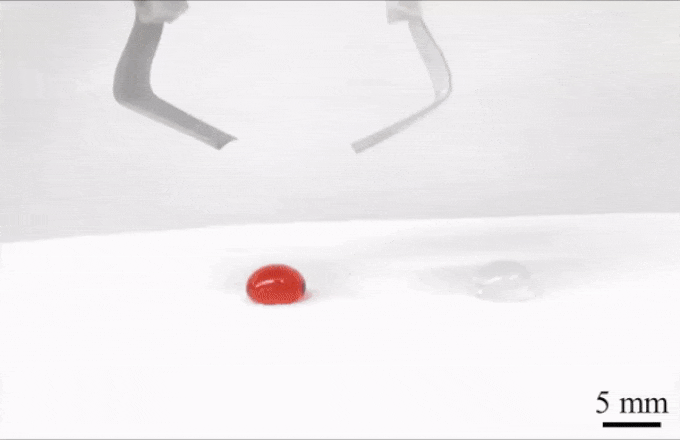New robot can pick up a single drop of liquid
Its soft, finger-size grippers are coated with a layer that repels everything

Picking up a single liquid droplet, like the one seen on this flower petal, is challenging — especially for a robot. But a new robotic device can nab a drop of any liquid and put it somewhere else without dirtying (or infecting) human hands.
Sonja Cvorovic/500px/Getty Images Plus
Share this:
- Share via email (Opens in new window) Email
- Click to share on Facebook (Opens in new window) Facebook
- Click to share on X (Opens in new window) X
- Click to share on Pinterest (Opens in new window) Pinterest
- Click to share on Reddit (Opens in new window) Reddit
- Share to Google Classroom (Opens in new window) Google Classroom
- Click to print (Opens in new window) Print
Scientists have designed plenty of devices that can pick up solid objects. Big mechanical claws can lift cars. Small claws can pluck prizes from a glass box in an arcade game. But these new pluckers can lift something else entirely — a liquid.
Engineers have built the first flexible grippers that can pick up and move a single drop of liquid. The device is made of flexible pincers. Each is about the size and shape of a finger. Experimental tests showed that the pair can scoop up droplets as small as 2 millimeters (0.08 inch) across.
Such a device might help scientists safely handle biological fluids, such as blood or saliva, says Arun Kota. That task could be particularly useful in laboratories where samples are tested for signs of COVID-19, flu or other contagious diseases. Kota is a mechanical engineer at North Carolina State University in Raleigh. He worked on these new grippers.
“Infectious fluids are a huge problem right now,” he says. “Could we use these robots as a sort of protective shield?”
His team described its new device in the November issue of Materials Horizons. They showed that the pincers not only work but can also be made from low-cost materials, such as ordinary double-stick tape. The grippers work with any kind of droplets. Still in the testing phase, they’re not ready for real-world use just yet.

Engineering something novel
The new device combines tech from two fields of engineering. One is soft robotics. Unlike robots made from hard and clunky materials such as metal, soft robots are made from squishy stuff. Mechanical engineer Jianguo Zhao, another scientist who worked on the device, develops soft robots. He works at Colorado State University in Fort Collins.
The other field is materials science, Kota’s area of expertise. More than 10 years ago, he started studying materials that are hydrophobic (Hy-droh-FOH-bik) — meaning water-repellent. Back then, he too worked at Colorado State University. He didn’t want to stop at repelling water. He wanted to design stuff that would repel any fluid. Working with Wei Wang, an engineer in his lab, he developed such materials. Wang led the new study.
“Many materials are repellent to water, but around alcohol or oil they’re no longer repellent,” Kota says. To describe their new material, Wang and Kota coined the word “super-omniphobic”. Omni means all things; phobic means repellent.
“Using soft-robot technology was a natural solution,” says Zhao. The flexibility of a soft robot, he says, made it great for handling something as delicate as a droplet. “We don’t want to break it up.”
Kota and Zhao had seen other scientists use small robots to move solids. But never liquids. So six years ago, they began testing ways to lift a droplet.
The part that makes the robot move — the actuator — was simple. It came from a design by Zhao. They twisted a nylon thread, like fishing line, into a coil. When voltage is applied to the coil, it expands. In that way, it acts like the robot’s “muscle.”
The researchers sandwiched the coil between two thin materials. One was rigid, so it resisted bending. The other material was ordinary double-stick tape. When a voltage was applied and the coil expanded, the flexible tape bent easily — and the other material didn’t.
“The difference in stiffness created a bending motion,” says Zhao. To an observer, it looks like a finger, slowly bending.
Finally, they sprayed the super-omniphobic coating on the tape. This ensured that the liquid droplet could be held by the gripper without sticking to it.
Finding a useful purpose for it
Getting the design right took months of trial and error. For example, the team struggled to find something that a super-omniphobic material would stick to. (If it repels everything, after all, then it shouldn’t stick to anything.) Kota likened it to paint on a wall: If a wall starts to bend, paint will flake off. But he notes that “when the actuator is deforming, the coating should not come off.” In the end, the tape’s rough adhesive surface worked to keep the coating on.
The group completed their design by 2017. Yet cool as it was, it had no obvious use.
But in 2020, the COVID-19 pandemic hit. Suddenly, this liquid droplet mover seemed like the right tech to help people safely handle toxic or infectious fluids. “They could use it to put the liquid in a vial [to] do a diagnostic test,” Kota explains.
Twist-and-coiled actuators offer a smart and simple way to power soft robots, says Xiaoguang Dong. He’s an engineer at Vanderbilt University in Nashville, Tenn. The new device, he says, cleverly combines two existing technologies.
But he doubts whether infectious disease labs are looking for such a device. “To me, this is not really practical,” he says. “The number of droplets that can be manipulated is very small. They need independently actuated robotic fingers to manipulate several [droplets]. If you want to manipulate hundreds of droplets, how do you do that?”
Kota and Zhao agree that more work is needed to make their grippers truly useful. “We only demonstrated a very simple motion,” says Zhao. His team is now collaborating with microbiologists and virologists on new devices that might rely on the new grippers.
“How can we manipulate the droplets in a realistic situation?” asks Kota. If they can figure that out, he says, the device could offer an inexpensive way to protect lab workers.
This is one in a series presenting news on technology and innovation, made possible with generous support from the Lemelson Foundation.







